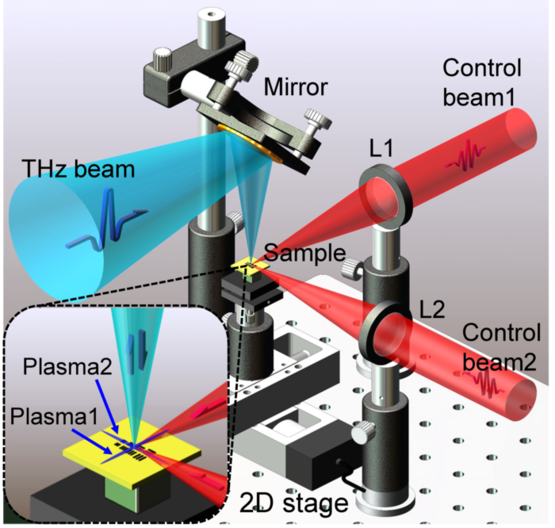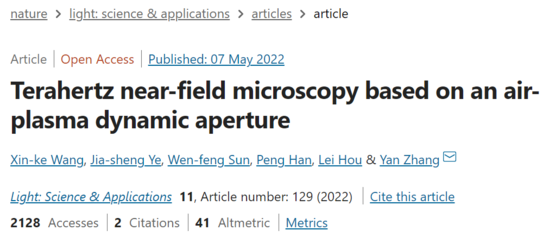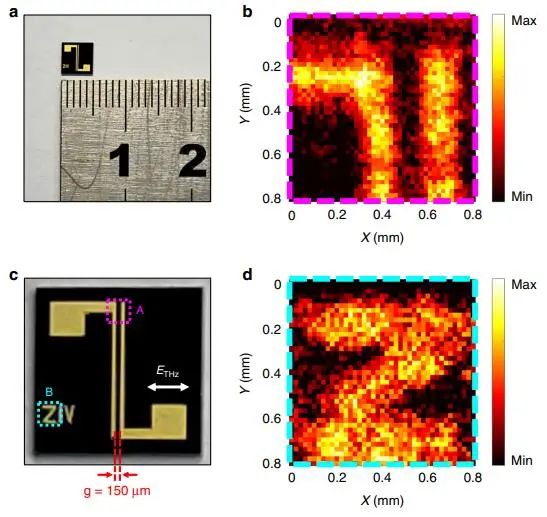As a new type of far-infrared detection method, terahertz (THz) imaging technology has received extensive attention in recent years. Due to the unique properties of terahertz radiation, such as low non-ionizing radiation energy and wide spectral information, this imaging technology shows strong application potential in many basic research and industrial fields. However, the imaging resolution of terahertz waves has been limited due to their longer wavelengths.
The introduction of optical near-field techniques can greatly improve resolution, but requires the terahertz source or detector to be as close to the sample as possible. For soft or liquid materials in biomedical sensing and chemical detection, conventional terahertz near-field techniques can easily damage samples and contaminate terahertz sources or detectors. Therefore, the use of terahertz near-field microscopy in a wider range of applications remains a challenge.

Schematic diagram of terahertz near-field microscope based on dynamic aperture of air plasma | XIN-KE WANG, JIA-SHENG YE, WEN-FENG SUN, PENG HAN, LEI HOU, AND YAN ZHANG
In a new paper published in the journal Light: Science & Applications , researchers from the Beijing Key Laboratory of Metamaterials and Devices, the Ministry of Education’s Key Laboratory of Terahertz Optoelectronics, and the Department of Physics, Capital Normal University A team of scientists led by Prof. Xinke Wang and Prof. Yan Zhang has developed a new type of terahertz near-field microscope that can achieve terahertz subwavelength imaging without the device being close to the sample.

webpage Screenshot
In this terahertz near-field technique, two overlapping air plasmas form a kind of cross filament, which opens a dynamic aperture to modulate the intensity of the terahertz beam at the sample surface. When the cross filament is close enough to the sample surface, terahertz imaging with a resolution of tens of micrometers can be achieved. This technique effectively eliminates the limitations of sample selection in conventional terahertz near-field imaging, minimizing damage to the sample.
To test the technology’s performance, the team measured terahertz subwavelength images of four materials, including metal resolution test maps, semiconductor chips, plastic models, and oil stains. Furthermore, the technique is in principle also suitable for encapsulating samples if the packaging is transparent to terahertz and visible light. Therefore, it is expected that the reported method will greatly broaden the applications of terahertz near-field microscopy, such as biomedical sensing and chemical detection.

Terahertz Near Field Imaging of Semiconductor Chips | Reference [1]
references
[1] Wang, Xk., Ye, Js., Sun, Wf. et al. Terahertz near-field microscopy based on an air-plasma dynamic aperture. Light Sci Appl 11, 129 (2022). https://ift. tt/h9mC5ro
[2] https://ift.tt/iFAK4pU
Compilation: Matrix Star
Edit: Crispy Fish
Typesetting: Yin Ningliu
Source of the title map: Reference [1]
research team
Corresponding author Zhang Yan: Professor of the Department of Physics, Capital Normal University, doctoral supervisor, candidate for the New Century Excellent Talents Program of the Ministry of Education, candidate for the Beijing Science and Technology Rising Star and Hundred Thousand Talents Program, Beijing Great Wall Scholar, Beijing Metamaterials and Devices Director of Beijing Key Laboratory. He graduated from Harbin Institute of Technology in 1994 and received his Ph.D. from the Institute of Physics, Chinese Academy of Sciences in 1999. He has successively engaged in research work at Yamagata University in Japan, Hong Kong Polytechnic University, University of Stuttgart in Germany, Hong Kong University of Science and Technology, Leinster University of Technology in the United States and University of Konstanz in Germany. Undertook 973 projects, more than 20 projects of the National Natural Science Foundation of China, published more than 200 SCI papers in international journals such as Nature Photonics , Nature Communications , Advance Optical Materials , etc., with more than 2,500 SCI citations, and made more than 30 invited reports at international conferences Second-rate.
The first author Wang Xinke: Associate Professor of the Department of Physics, Capital Normal University. He received his PhD in optics from Harbin Institute of Technology in 2011. During his PhD, he was mainly engaged in the research and development of focal plane terahertz pulse imaging technology. From 2009 to 2010, he went to Rensselaer Polytechnic Institute in the United States for a one-year doctoral joint training study. He joined Capital Normal University in 2011 and obtained the title of associate professor in 2013. He has published more than 30 SCI papers in journals such as Advanced Optical Materials , Optics Letters , Optics Express , Applied Physics Letters , Scientific Reports , etc.; 1, 1 national invention patent, 1 utility model patent; has presided over 4 projects such as the National Natural Science Foundation of China, the National “863” Program, and the Beijing Natural Science Foundation.
Paper information
Published the journal ” Light: Science & Applications “
Posted on May 7, 2022
Paper title Terahertz near-field microscopy based on an air-plasma dynamic aperture
(DOI: https://ift.tt/kWtupB7)
Article Field Terahertz Spectroscopy and Imaging
The Future Light Cone Accelerator is an early-stage technology entrepreneurship accelerator initiated by Nutshell Technology. It provides scientists with solutions at different stages ranging from company registration, intellectual property rights, to financing needs, and team formation. Accelerate the transformation of scientific and technological achievements from the laboratory to the market, and accelerate the iteration of some scientists to become CEOs.
The Nutshell team has 12 years of experience in serving scientists. We always make suggestions from the perspective of scientists and be good friends of science and technology creators. If you are planning to start a technology business, whether you are looking for money, people, resources, or orders, you are welcome to chat with the Future Light Cone team. You can send bp or other project information to [email protected] , and leave your contact information, or add the Wechat of Guoke Hard Technology Enterprise to communicate by private message.

✦
✦
Click to read the original text to view the original paper
This article is reproduced from: http://www.guokr.com/article/462204/
This site is for inclusion only, and the copyright belongs to the original author.